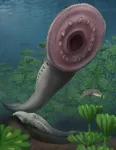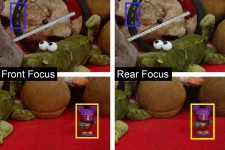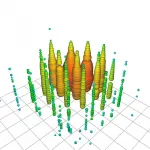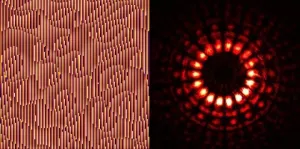INFORMATION:
Other contributors to this work include Martina Sgritta, Cecilia Noecker, Oscar D. Murillo, Daniela F. Felice and Peter J. Turnbaugh. The authors are affiliated with one or more of the following institutions: Baylor College of Medicine, University of California, San Francisco and Chan Zuckerberg Biohub.
This work was supported by funding from NIH (R01 MH112356, R01 HL122593, R01 DK114034, 2T32AI060537-16), Sammons Enterprise, Nadia's Gift Foundation Innovator and Damon Runyon Cancer Research Foundation (DRR-42-16).
Microbes may hold the key for treating neurological disorders
2021-03-10
(Press-News.org) When we think about the causes of neurological disorders and how to treat them, we think about targeting the brain. But is this the best or only way? Maybe not. New research by scientists at Baylor College of Medicine suggests that microbes in the gut may contribute to certain symptoms associated with complex neurological disorders. The findings, published in the journal Cell, also suggest that microbe-inspired therapies may one day help to treat them.
Dr. Mauro Costa-Mattioli, professor and Cullen Foundation Endowed Chair in neuroscience and director of the Memory and Brain Research Center at Baylor, discovered with his team that different abnormal behaviors are interdependently regulated by the host's genes and microbiome. Specifically, the team found that in mouse models for neurodevelopmental disorders, hyperactivity is controlled by the host's genetics, whereas social behavior deficits are mediated by the gut microbiome.
More importantly from a therapeutic perspective, they found that treatment with a specific microbe that promotes the production of compounds in the biopterin family in the gut or treatment with a metabolically active biopterin molecule improved the social behavior but not motor activity.
"We are the bearers of both host and microbial genes. While most of the focus has traditionally been in host genes, the gut microbiome, the community of microorganisms that live within us, is another important source of genetic information," Costa-Mattioli said.
The work by Costa-Mattioli's group offers a different way of thinking about neurological disorders in which both human and microbial genes interact with each other and contribute to the condition. Their findings also suggest that effective treatments would likely need to be directed at both the brain and the gut to fully address all symptoms. Additionally, they open the possibility that other complex conditions, such as cancer, diabetes, viral infection or other neurological disorders may have a microbiome component.
Brain-gut-microbiome crosstalk
"It's very difficult to study these complex interactions in humans, so in this study, we worked with a mouse model for neurodevelopmental disorders in which the animals lacked both copies of the Cntnap2 gene (Cntnap2-/- mice)," said co-first author Sean Dooling, a Ph.D. candidate in molecular and human genetics in the Costa-Mattioli lab. "These mice presented with social deficits and hyperactivity, similar to those observed in autism spectrum disorders (ASD). In addition, these mice, like many people with ASD, also had changes in the bacteria that make up their microbiome compared to the mice without the genetic change."
Further experiments showed that modulating the gut microbiome improved the social behavior in the mutant mice, but did not alter their hyperactivity, indicating that the changes in the microbiome selectively contribute to the animals' social behavior.
"We were able to separate the contribution of the microbiome and that of the animal's genetic mutation on the behavioral changes," Dooling said. "This shows that the gut microbiome shouldn't be ignored as an important variable in studying health and disease."
Equipped with this knowledge, the researchers dug deeper into the mechanism underlying the microbiome's effect on the animal's social deficits. Based on their previous work, the investigators treated the mice with the probiotic microbe, L. reuteri.
"We found that L. reuteri also can restore normal social behavior but cannot correct the hyperactivity in Cntnap2-/- mice," said co-first author Dr. Shelly Buffington, a former postdoctoral fellow in the Costa-Mattioli lab and now an assistant professor at the University of Texas Medical Branch in Galveston.
However, the bigger surprise came when the investigators administered to the asocial mice a metabolite or compound they found was increased in the host's gut by L. reuteri. They discovered that the animals' social deficits also were improved after treating them with the metabolite instead of the bacteria.
"This provides us with at least two possible ways to modulate the brain from the gut, with the bacteria or the bacteria-induced metabolite," said Buffington.
Bacteria to heal your brain & beyond
Could this work inspire new breakthroughs in treating neurological disorders? While it is still too early to say for sure, the investigators are particularly excited about the translational implications of their findings.
"Our work strengthens an emerging concept of a new frontier for the development of safe and effective therapeutics that target the gut microbiome with selective probiotic strains of bacteria or bacteria-inspired pharmaceuticals," Buffington said.
"As we learn more about how these bacteria work, we will be able to more precisely and effectively leverage their power to help treat the brain and perhaps more," Dooling added.
This research represents important step forward in the field as many disorders, especially those affecting the brain, remain very difficult to treat.
"Despite all the scientific advances and the promise of gene manipulation, it is still difficult to modulate human genes to treat diseases, but modulating our microbiome may be an interesting, noninvasive alternative," said Costa-Mattioli. Indeed, L. reuteri currently is being tested in a clinical trial in Italy in children with autism, and Costa-Mattioli aims to start his own trial soon.
"In my wildest dreams, I could have never imagined that microbes in the gut could modulate behavior and brain function. To think now that microbial-based strategies may be a viable way to treat neurological dysfunction, is still wild, but very exciting."
ELSE PRESS RELEASES FROM THIS DATE:
Long-accepted theory of vertebrate origin upended by fossilized lamprey larvae
2021-03-10
Ottawa, March 10, 2021 - A new study of fossilized lampreys dating from more than 300 million years ago is challenging a long-held theory about the evolutionary origin of vertebrates (all animals with a backbone). The findings are published March 10 in the science journal Nature.
Lampreys are ancient, jawless, eel-like fishes that arose around half a billion years ago and they have long provided insights into vertebrate evolution. Now, scientists with the Canadian Museum of Nature, the University of Chicago and the Albany Museum in South Africa are reporting their analysis of dozens of tiny fossils that track the life stages and growth of ancient lampreys, from hatchlings to juveniles to adults.
Their results counter the established view that the blind, filter-feeding ...
Long-accepted theory of vertebrate origin upended by fossilized fish larvae
2021-03-10
A new study out of the University of Chicago, the Canadian Museum of Nature and the Albany Museum challenges a long-held hypothesis that the blind, filter-feeding larvae of modern lampreys are a holdover from the distant past, resembling the ancestors of all living vertebrates, including ourselves. The new fossil discoveries indicate that ancient lamprey hatchlings more closely resembled modern adult lampreys, and were completely unlike their modern larvae counterparts. The results were published on March 10 in Nature.
Lampreys -- unusual jawless, eel-like, creatures -- have long provided insights ...
Using artificial intelligence to generate 3D holograms in real-time
2021-03-10
Despite years of hype, virtual reality headsets have yet to topple TV or computer screens as the go-to devices for video viewing. One reason: VR can make users feel sick. Nausea and eye strain can result because VR creates an illusion of 3D viewing although the user is in fact staring at a fixed-distance 2D display. The solution for better 3D visualization could lie in a 60-year-old technology remade for the digital world: holograms.
Holograms deliver an exceptional representation of 3D world around us. Plus, they're beautiful. (Go ahead -- check out the holographic dove on your Visa card.) Holograms offer a shifting perspective based on the viewer's position, and they allow the eye to adjust focal depth to alternately focus on foreground and background.
Researchers have long sought ...
IceCube detection of a high-energy particle proves 60-year-old theory
2021-03-10
On December 6, 2016, a high-energy particle called an electron antineutrino hurtled to Earth from outer space at close to the speed of light carrying 6.3 petaelectronvolts (PeV) of energy. Deep inside the ice sheet at the South Pole, it smashed into an electron and produced a particle that quickly decayed into a shower of secondary particles. The interaction was captured by a massive telescope buried in the Antarctic glacier, the IceCube Neutrino Observatory.
IceCube had seen a Glashow resonance event, a phenomenon predicted by Nobel laureate physicist ...
Finding quvigints in a quantum treasure map
2021-03-10
Researchers have struck quantum gold--and created a new word--by enlisting machine learning to efficiently navigate a 20-dimensional quantum treasure map.
Physicist Dr Markus Rambach from the ARC Centre of Excellence for Engineered Quantum Systems (EQUS) at The University of Queensland said the team was able to find unknown quantum states more quickly and accurately, using a technique called self-guided tomography.
The team also introduced the 'quvigint', which is like a qubit (the quantum version of a classical bit that takes on the values '0' or '1') except that it takes on not two, but 20 possible values.
Dr ...
Risk factors associated With SARS-CoV-2 seropositivity among US health care personnel
2021-03-10
What The Study Did: In this study, most risk factors associated with SARS-CoV-2 infection among health care workers were outside the workplace.
Authors: Jesse T. Jacob, M.D., of Emory University in Atlanta, is the corresponding author.
To access the embargoed study: Visit our For The Media website at this link https://media.jamanetwork.com/
(doi:10.1001/jamanetworkopen.2021.1283)
Editor's Note: The article includes conflict of interest and funding/support disclosures. Please see the article for additional information, including other authors, author contributions and affiliations, conflict of interest and financial disclosures, and funding and support.
INFORMATION:
Media ...
IceCube detection of high-energy particle proves 60-year-old physics theory
2021-03-10
MADISON - On December 6, 2016, a high-energy particle hurtled to Earth from outer space at close to the speed of light. The particle, an electron antineutrino, smashed into an electron deep inside the ice sheet at the South Pole. This collision produced a particle that quickly decayed into a shower of secondary particles, triggering the sensors of the IceCube Neutrino Observatory, a massive telescope buried in the Antarctic glacier.
IceCube had seen a Glashow resonance event, a phenomenon predicted by Nobel laureate physicist Sheldon Glashow in 1960. With this detection, scientists provided another confirmation of the Standard Model of particle physics. It ...
SARS-CoV-2 seroprevalence, symptom onset in culturally linked orthodox Jewish communities across multiple US regions
2021-03-10
What The Study Did: This study of orthodox Jewisha dults across the United States found that socioculturally bound communities experienced early parallel outbreaks in discrete locations, notably prior to substantive medical and governmental directives.
Authors: Jonathan I. Silverberg, M.D., Ph.D., M.P.H., of George Washington University in Washington, D.C., and Avi Z. Rosenberg, M.D., Ph.D., of Johns Hopkins University in Baltimore, are the corresponding authors.
To access the embargoed study: Visit our For The Media website at this link https://media.jamanetwork.com/
(doi:10.1001/jamanetworkopen.2021.2816)
Editor's Note: The article includes conflict of interest and funding/support disclosures. ...
Association of age with likelihood of developing symptoms, critical disease among close contacts exposed to patients with confirmed SARS-CoV-2 infection
2021-03-10
What The Study Did: In a study of Italian close contacts of patients with confirmed SARS-CoV-2 infection, most infected contacts (1,948 of 2,824 individuals or 69%) didn't develop respiratory symptoms or fever 37.5 degrees Celsius (99.5 degrees Fahrenheit) or higher; 26.1% of infected individuals younger than 60 developed respiratory symptoms or fever 37.5 degrees Celsius (99.5 degrees Fahrenheit); and 6.6% of infected participants age 60 or older developed critical disease.
Authors: Piero Poletti, Ph.D., of Fondazione Bruno Kessler in Trento, ...
Implementation of recuperation unit, hospitalization rates among people experiencing homelessness with COVID-19
2021-03-10
What The Study Did: Boston experienced a COVID-19 surge that disproportionately affected persons experiencing homelessness and a large safety-net hospital implemented a novel COVID-19 recuperation unit for these patients that provided isolation, quarantine and treatment for substance use. Researchers aimed to determine the association of the care provided by the unit with COVID-19 hospitalizations among people experiencing homelessness.
Authors: Joshua A. Barocas, M.D., of Boston Medical Center, is the corresponding author.
To ...



